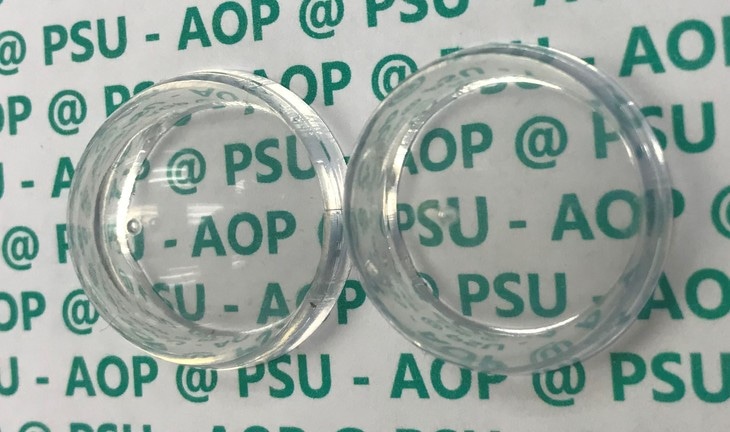Jan 30 2019
There are a large number of practical applications for antireflection (AR) coatings on plastics, such as glare reduction on computer monitors, eyeglasses, and the display on smartphone when outdoors.
 Plastic dome coated with a new antireflection coating (right), and uncoated dome (left). (Image credit: Giebink Lab/Penn State)
Plastic dome coated with a new antireflection coating (right), and uncoated dome (left). (Image credit: Giebink Lab/Penn State)
Scientists at Penn State have currently produced an AR coating that enhances existing coatings to such an extent that it can make transparent plastics, for example, Plexiglas, almost invisible.
This discovery came about as we were trying to make higher-efficiency solar panels. Our approach involved concentrating light onto small, high-efficiency solar cells using plastic lenses, and we needed to minimize their reflection loss.
Chris Giebink, Associate Professor, Department of Electrical Engineering, Penn State
The researchers required an antireflection coating that worked well over the whole solar spectrum as well as at multiple angles as the sun moved across the sky. They were also in need of a coating that could endure weather over longer periods of time outdoors.
“We would have liked to find an off-the-shelf solution, but there wasn’t one that met our performance requirements,” he said. “So, we started looking for our own solution.”
That was a difficult task. It is quite simple to develop a coating that will eliminate reflection at a specific wavelength or in a specific direction; however, one that could satisfy all their standards did not exist. For example, eyeglass AR coatings are aimed at the narrow visible portion of the spectrum. However, the solar spectrum is around five times as wide as the visible spectrum, hence such a coating would not work well for a concentrating solar cell system.
Light is reflected when it travels from one medium, for example, air, into another medium, such as plastic in this case. If there is a huge difference in their refractive index, which describes the rate at which light travels in a specific material—air has a refractive index of 1 and plastic has a refractive index of 1.5—then several reflections will occur. A natural coating material such as Teflon or magnesium fluoride has the lowest refractive index of around 1.3. By combining various materials, it is possible to grade—slowly vary—refractive index between 1.3 and 1.5; however, there is still a gap between 1.3 and 1.
In a paper recently published online prior to print in the journal Nano Letters, Giebink and coauthors address a new process to fill the gap between Teflon and air. They created nanoscale pores in evaporated Teflon using a sacrificial molecule, thus producing a graded index Teflon-air film that deceives light into seeing a smooth transition from 1 to 1.5, typically removing all reflections.
“The interesting thing about Teflon, which is a polymer, is when you heat it up in a crucible, the large polymer chains cleave into smaller fragments that are small enough to volatize and send up a vapor flux. When these land on a substrate they can repolymerize and form Teflon,” stated Giebink.
Upon introducing the sacrificial molecules to the flux, the Teflon will reform around the molecules. By dissolving the sacrificial molecules out, a nanoporous film is formed that can be graded by adding more pores.
We’ve been interacting with a number of companies that are looking for improved antireflection coatings for plastic, and some of the applications have been surprising. They range from eliminating glare from the plastic domes that protect security cameras to eliminating stray reflections inside virtual/augmented-reality headsets.
Chris Giebink, Associate Professor, Department of Electrical Engineering, Penn State
One surprising application is in high altitude unmanned aerial vehicles, or UAVs. These are planes that have large wingspans coated with solar cells. Used mainly for exploration, these planes depend on sunlight to stay in near perpetual flight and hence most of the light they receive is at a glancing angle where reflections are highest. One of the companies that manufacture these solar cells is investigating the AR coating to observe whether it can increase the amount of light obtained by a UAV.
As the technology is compatible with existing manufacturing methods, Giebink hopes that the coating technology can be extensively applied and scaled. At this point, his test samples have endured central Pennsylvania weather for two years, with minor changes in properties. Furthermore, the coating is also antifogging.
The coating adheres well to different types of plastics, but not glass. So, it’s not going to be useful for your typical rooftop solar panel with a protective glass cover. But if concentrating photovoltaics make a comeback, a critical part of those is the plastic Fresnel lenses, and we could make a difference there.
Chris Giebink, Associate Professor, Department of Electrical Engineering, Penn State
Additional authors on the paper, “Graded-Index Fluoropolymer Antireflection Coatings for Invisible Plastic Optics,” are first author and former postdoctoral scholar Baomin Wang, graduate students Christian Ruud and Jared Price, and current postdoctoral scholar Hoyeon Kim.
This research was supported by the Advanced Research Projects Agency-Energy and the National Science Foundation.